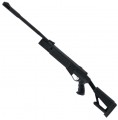Adjustable trigger
The ability to adjust the features of the trigger triggering of the rifle — first of all, the idle (before triggering) stroke of the trigger and the force on the hook. This allows you to optimally adjust the characteristics of the weapon to the personal preferences of everyone: for example, it is usually difficult for beginners to shoot with a tight trigger, but for trained shooters, a too soft hook that “falls through” under the finger may be inconvenient.
Barrel length
The working length of the rifle barrel is from the chamber where the bullet is loaded to the muzzle. The shortest barrels found nowadays have a length
of just over 200 mm(and in some AEGs even
less than this value); the longest reach
500 – 600 mm.
There is a stereotype that the muzzle velocity directly depends on the length of the barrel. In firearms, this is true — but not in pneumatics. Firstly, in such rifles, the initial velocity depends on a number of other indicators — pressure, the quality of the barrel treatment, the efficiency of the valves, etc. on the first 20 – 25 cm of the barrel, then the gas pressure drops noticeably. The exception is PCP rifles, in which the longer barrel really makes it easier to achieve high speeds. However, again, so many additional factors affect the final result that models with the same barrel length can differ markedly in initial speed.
The second common stereotype is that a longer barrel improves accuracy and accuracy. This is true in the context that a longer barrel allows for a greater distance between the front and rear sights, making it easier to aim carefully. Technical accuracy does not depend on the length, but on the quality of the barrel processing.
Summing up all of the above, we can say that the length of the barrel for an air rifle is more of a reference than a really significant paramete
...r, and when choosing, it is better to focus on more "close to life" characteristics — first of all, directly claimed muzzle velocity.Stock material
—
Tree. A classic material used in firearms and then pneumatic weapons since ancient times (in fact, since its inception). Wooden stocks are strong enough on their own, and in modern rifles they are also amenable to special treatment to protect against dampness, temperature changes, etc .; while the rifles have a nice appearance in a classic style. At the same time, the wood is prone to abrasion, scratches easily appear on it, and there is a possibility of cracks. When used in simple conditions, such as periodic "shooting" in the country, this does not matter, however, for example, a wooden stock is not suitable for hunting — at least because it will quickly lose its "presentation". At the same time, this material is also somewhat more expensive and more difficult to process than plastic that is more resistant to “troubles”. Therefore, today the tree is used mainly in pneumatics of the middle and upper price range and is designed for those who are primarily interested in the aesthetics of weapons.
—
Plastic. One of the most popular materials for the manufacture of modern pneumatics. Such stocks are easy to manufacture and inexpensive, while the plastic can be given a rather complex shape without any problems, which, in particular, facilitates the installation of various adjustment systems (see “Cheek Adjustment”, “Butt / Stock Adjustment”). However, its main advantage is practicality: this materia
...l is resistant to impacts, cracks and scratches, comparable in strength to wood (or even superior) and has a small weight. As a result, plastic has become widespread in almost all price ranges.
— Aluminium. A fairly advanced material that combines low weight and high strength. On the other hand, aluminium stocks for classic pneumatics are generally expensive, and therefore are used mainly in high-end professional models (although there are exceptions). But in airsoft rifles that copy real weapons, the situation is somewhat different: there aluminium can be used as a simpler and more affordable alternative to steel (from which gunshot prototypes are made).
